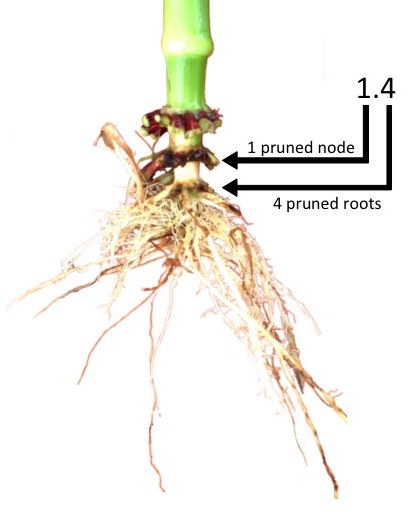| Larvae: Node-Injury Scale |
|
|
A number of approaches have been used to for determining how effective corn rootworm control tactics have been. They include taking larval counts, collecting adults as they emerge from the soil, root damage ratings, root size and regrowth ratings, measuring root-pull resistance, recording the percentage of lodged plants and measuring grain yield. Over time root ratings have become the generally accepted standard for checking the efficacy of corn rootworm control measures. This has been due in large part to the fact that it is relatively efficient and provides a reliable indicator of corn rootworm presence and damage. While other characteristics previously used such as grain yield, root-pull resistance, lodging, etc., all show high variability from one field to the next. Another advantage of the node-injury scale is the linear relation between the scale and the amount of root injury. The linear relationship allows for greater accuracy and precision when evaluating corn roots for corn rootworm damage.
|
 |
| This approach involves digging corn roots and then assessing them for damage due to larval injury. When corn rootworm larvae feed, the roots are trimmed back, leaving a characteristic brown scarring color. When digging roots it is best to dig away from the plant far enough that the pruning observed is from the corn rootworm larvae and not a shovel. The roots are then cleaned and given a score on the node-injury scale. The roots should be taken from different places within the field to get an accurate representation of the population densities of the entire field. |
 |
| When rating roots using the node-injury scale the first step is to select several random roots and calculate the average number of roots per node for the nodes where injury occurs (generally the 5th and 6th nodes). The next step is to examine the roots system and determine if a node of roots has been eaten. The node-injury scale score will be a ratio of pruned roots to healthy roots per node. If one node is completely pruned, that would give it a score of one. The score for the different nodes are added up for the total score. If all nodes are pruned it is given a score of 3, the highest value on the node-injury scale. |
| The node-injury scale score can be best used as an indicator of the effectiveness of your control practices, and provide input into your management plan for next year. Due to the fact that it is a measurement taken after damage is done they are not always useful for in-season management decisions. Also, this information may be used by companies when talking about the performance of their products, so it is important to understand this scale. |
| Another similar practice is to take a cube of soil and put it in a bucket of water and count the number of larvae that float to the top of the water. Often sugar or salt is added to the water to get them to float. Except for in special circumstances this approach doesn’t provide valuable information because of the limited number of effective control options available for controlling larvae at this stage. However, larval sampling and root ratings are a powerful tool in research, especially the root-node injury scale. |
| Root Ratings Activity |
| The activity below provides more information and practice on using the root rating scale. As mentioned above it is based on the number of pruned nodes and roots. |

